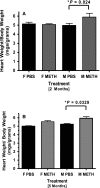Sex influences susceptibility to methamphetamine cardiomyopathy in mice
- PMID: 30891941
- PMCID: PMC6424857
- DOI: 10.14814/phy2.14036
Sex influences susceptibility to methamphetamine cardiomyopathy in mice
Abstract
In this study, we created a mouse model of methamphetamine cardiomyopathy that reproduces the chronic, progressive dosing commonly encountered in addicted subjects. We gradually increased the quantity of methamphetamine given to C57Bl/6 mice from 5 to 40 mg/kg over 2 or 5 months during two study periods. At the fifth month, heart weight was increased, echocardiograms showed a dilated cardiomyopathy and survival was lower in males, with less effect in females. Interestingly, these findings correspond to previous observations in human patients, suggesting greater male susceptibility to the effects of methamphetamine on the heart. Transcriptional analysis showed changes in genes dysregulated in previous methamphetamine neurological studies as well as many that likely play a role in cardiac response to this toxic stress. We expect that a deeper understanding of the molecular biology of methamphetamine exposure in the heart will provide insights into the mechanism of cardiomyopathy in addicts and potential routes to more effective treatment.
Keywords: Cardiomyopathy; gender; methamphetamine; transcription.
© 2019 The Authors. Physiological Reports published by Wiley Periodicals, Inc. on behalf of The Physiological Society and the American Physiological Society.
Conflict of interest statement
None declared.
Figures






Similar articles
-
The Black Book of Psychotropic Dosing and Monitoring.Psychopharmacol Bull. 2024 Jul 8;54(3):8-59. Psychopharmacol Bull. 2024. PMID: 38993656 Free PMC article. Review.
-
Corticosteroids for the treatment of Duchenne muscular dystrophy.Cochrane Database Syst Rev. 2016 May 5;2016(5):CD003725. doi: 10.1002/14651858.CD003725.pub4. Cochrane Database Syst Rev. 2016. PMID: 27149418 Free PMC article.
-
Sertindole for schizophrenia.Cochrane Database Syst Rev. 2005 Jul 20;2005(3):CD001715. doi: 10.1002/14651858.CD001715.pub2. Cochrane Database Syst Rev. 2005. PMID: 16034864 Free PMC article.
-
Timing of Methamphetamine Exposure during Adolescence Differentially Influences Parvalbumin and Perineuronal Net Immunoreactivity in the Medial Prefrontal Cortex of Female, but Not Male, Rats.Dev Neurosci. 2025;47(1):27-39. doi: 10.1159/000538608. Epub 2024 Mar 28. Dev Neurosci. 2025. PMID: 38547851 Free PMC article.
-
Sex and gender as predictors for allograft and patient-relevant outcomes after kidney transplantation.Cochrane Database Syst Rev. 2024 Dec 19;12(12):CD014966. doi: 10.1002/14651858.CD014966.pub2. Cochrane Database Syst Rev. 2024. PMID: 39698949
Cited by
-
Dapagliflozin Protects Methamphetamine-Induced Cardiomyopathy by Alleviating Mitochondrial Damage and Reducing Cardiac Function Decline in a Mouse Model.Front Pharmacol. 2022 Jul 7;13:925276. doi: 10.3389/fphar.2022.925276. eCollection 2022. Front Pharmacol. 2022. PMID: 35873593 Free PMC article.
-
Cannabidiol attenuates methamphetamine-induced cardiac inflammatory response through the PKA/CREB pathway in rats.Ann Transl Med. 2022 Sep;10(18):985. doi: 10.21037/atm-22-4082. Ann Transl Med. 2022. PMID: 36267753 Free PMC article.
-
Methamphetamine-induced changes in myocardial gene transcription are sex-dependent.BMC Genomics. 2021 Apr 12;22(1):259. doi: 10.1186/s12864-021-07561-x. BMC Genomics. 2021. PMID: 33845768 Free PMC article.
-
A Mechanistic Review on Toxicity Effects of Methamphetamine.Int J Med Sci. 2025 Jan 1;22(3):482-507. doi: 10.7150/ijms.99159. eCollection 2025. Int J Med Sci. 2025. PMID: 39898237 Free PMC article. Review.
-
Cardiomyopathy-Associated Hospital Admissions Among Methamphetamine Users: Geographical and Social Disparities.JACC Adv. 2024 Mar 13;3(7):100840. doi: 10.1016/j.jacadv.2024.100840. eCollection 2024 Jul. JACC Adv. 2024. PMID: 39130045 Free PMC article.
References
-
- Bingle, L. , and Bingle C. D.. 2011. Distribution of human PLUNC/BPI fold‐containing (BPIF) proteins. Biochem. Soc. Trans. 39:1023–1027. - PubMed
-
- Bourque, M. , Liu B., Dluzen D. E., and Di Paolo T.. 2011. Sex differences in methamphetamine toxicity in mice: effect on brain dopamine signaling pathways. Psychoneuroendocrinology 36:955–969. - PubMed
-
- Dluzen, D. E. , and Liu B.. 2008. Gender differences in methamphetamine use and responses: a review. Gend. Med. 5:24–35. - PubMed
Publication types
MeSH terms
Substances
Grants and funding
LinkOut - more resources
Full Text Sources
Medical
Molecular Biology Databases

